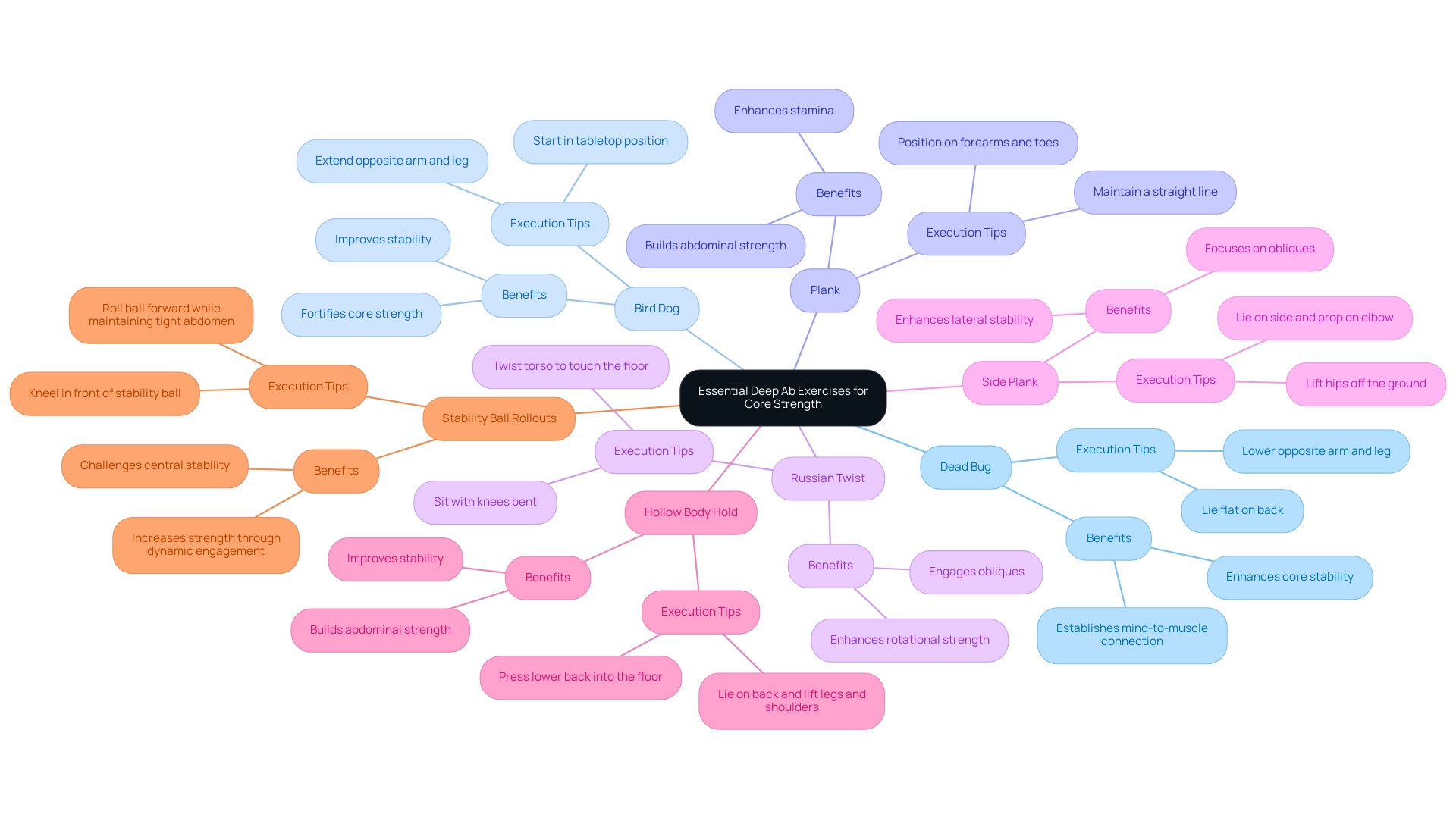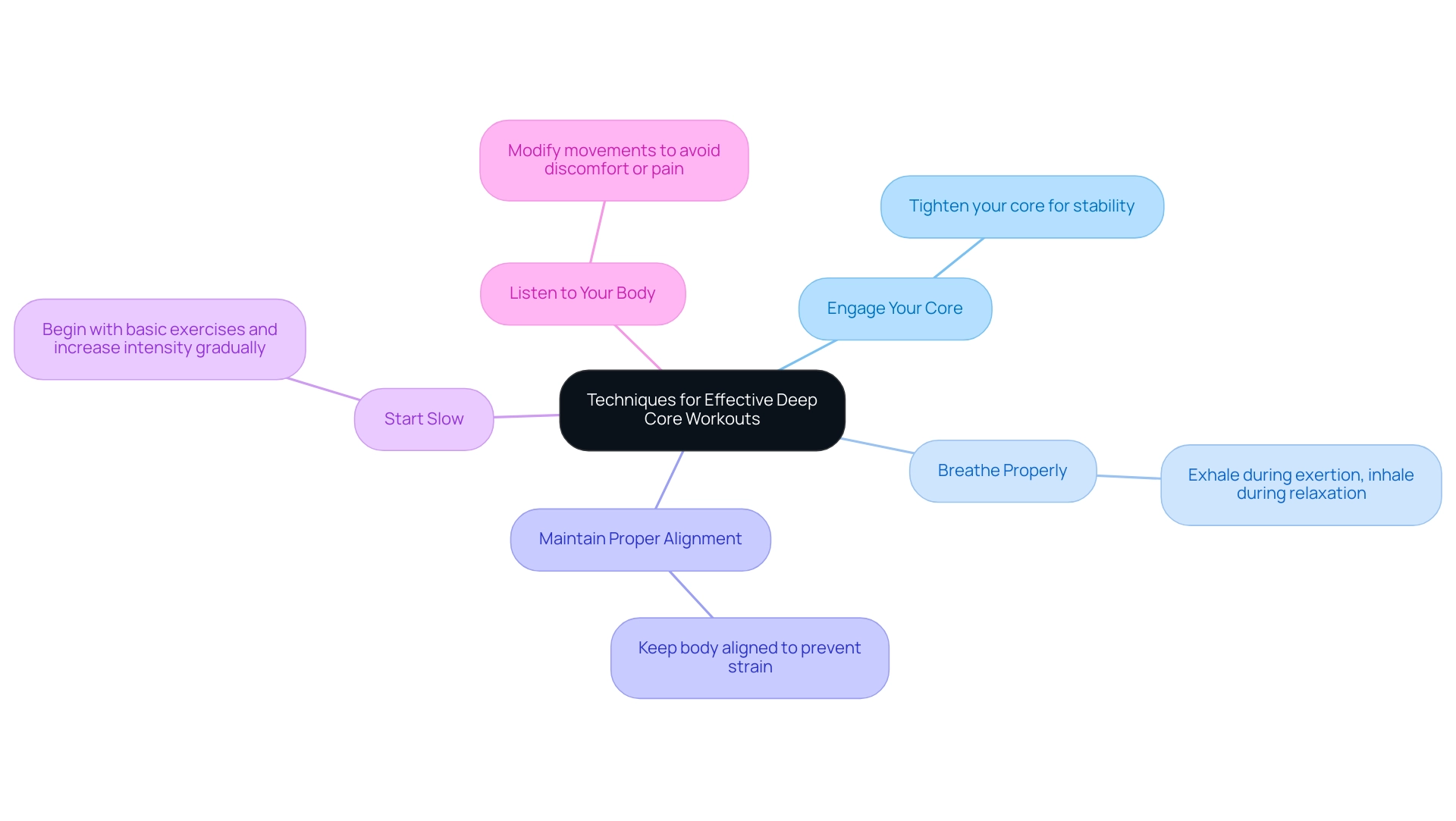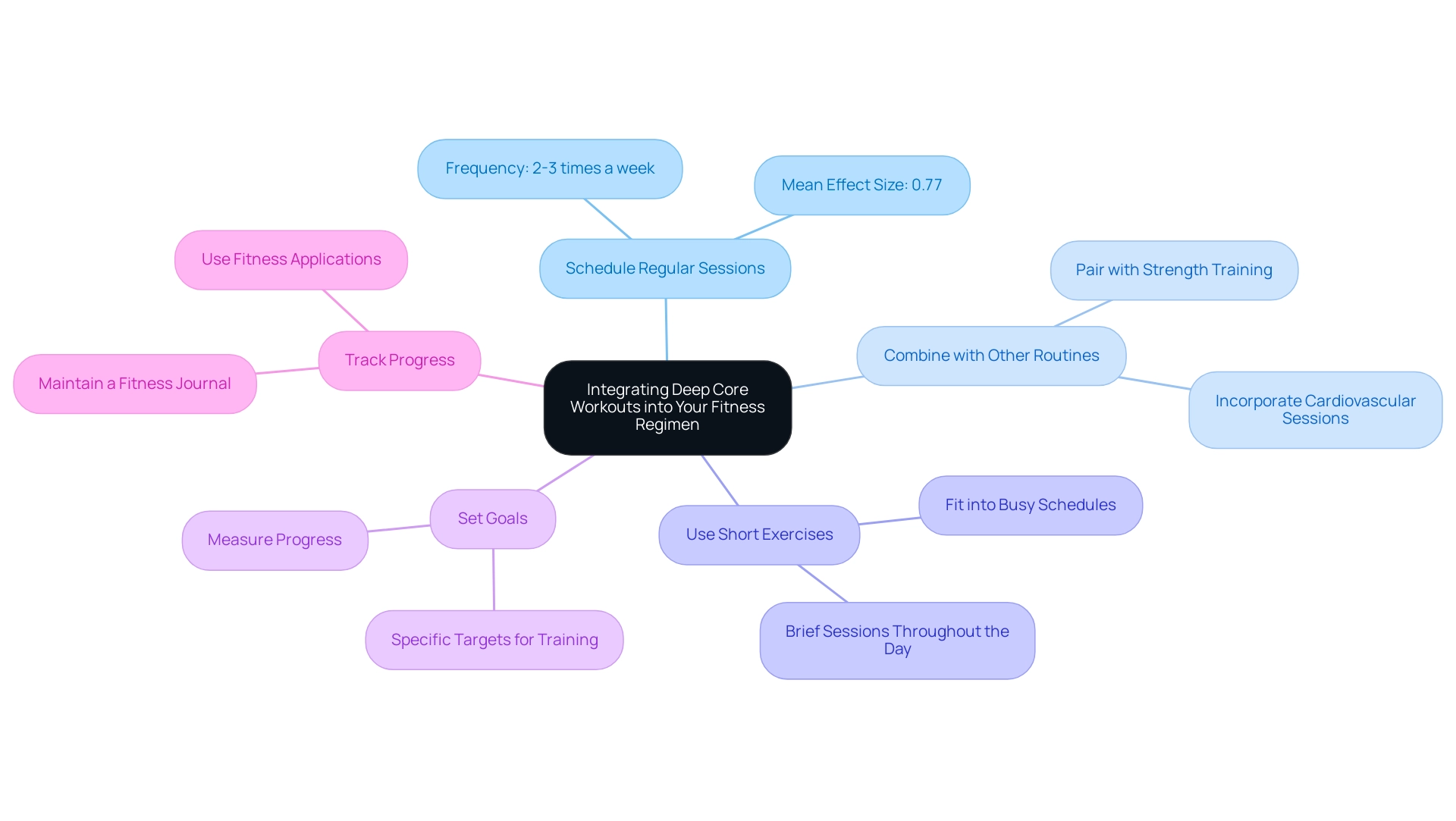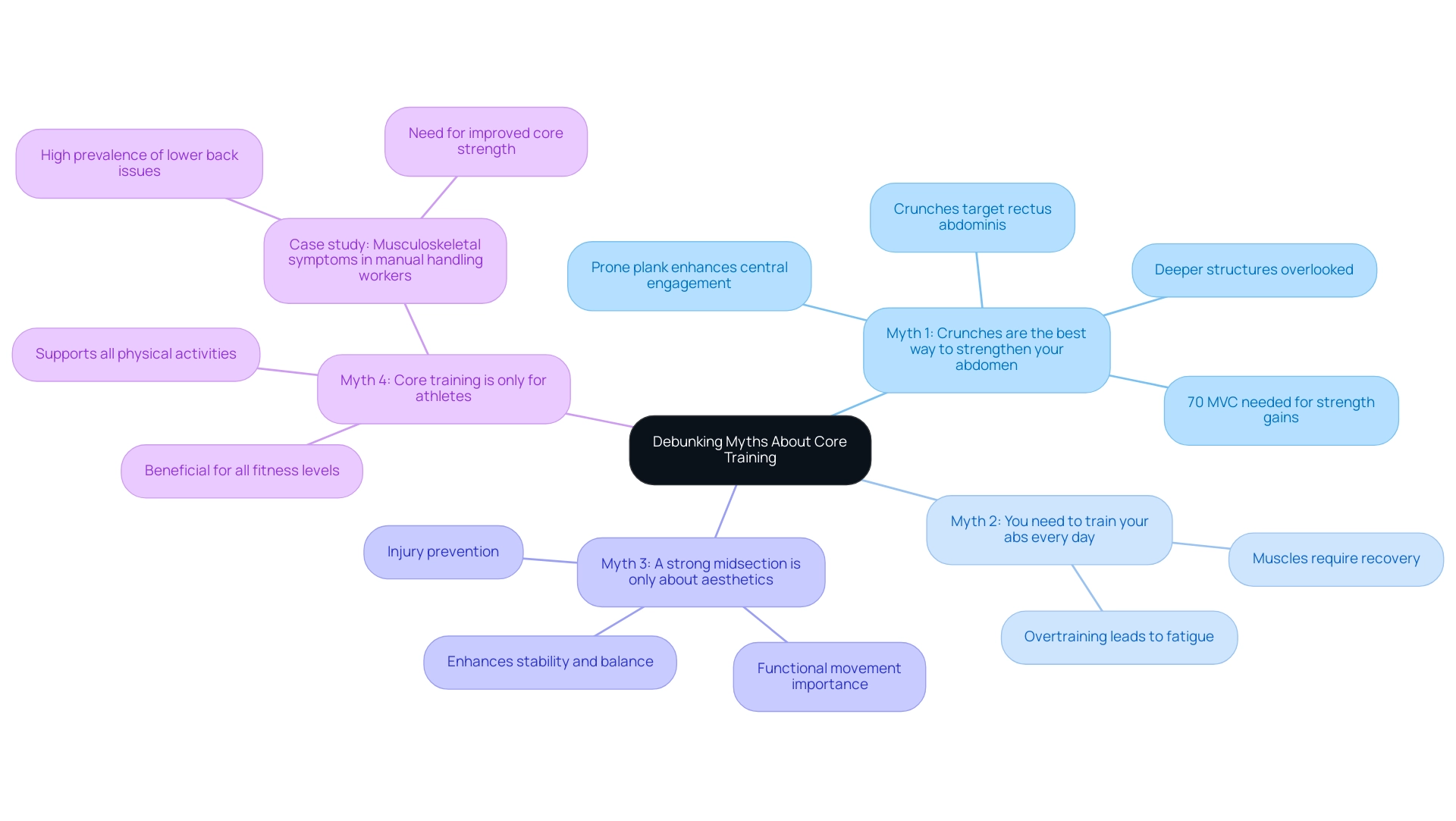Overview
This article underscores the vital role of deep abdominal workouts in cultivating a stronger core and enhancing overall fitness. It highlights that exercises targeting the transverse abdominis, pelvic floor, and diaphragm are essential for stability, injury prevention, and improved athletic performance. Supported by expert insights and research findings, the effectiveness of specific exercises, such as the bird dog and side plank, is convincingly demonstrated.
Introduction
In the quest for fitness, the significance of deep core muscles is frequently eclipsed by the appeal of superficial aesthetics. However, these hidden powerhouses—comprising the transverse abdominis, pelvic floor, and diaphragm—are essential in stabilizing the body, enhancing performance, and preventing injuries.
As more individuals acknowledge the necessity of integrating targeted core workouts into their routines, the benefits extend well beyond athletic prowess, influencing both everyday activities and overall well-being.
With insights from fitness experts and compelling research, this article explores the importance of deep core training, the numerous advantages it offers, essential exercises for building strength, and effective techniques for incorporating these workouts into daily life.
By dispelling common myths and providing strategies for consistency, readers will uncover how to unlock the full potential of their core, fostering a healthier, more resilient body.
1. Understanding Deep Core Muscles and Their Importance
The deep foundational tissues, which comprise the transverse abdominis, pelvic floor, and diaphragm, are essential for stabilizing both the spine and pelvis. Often neglected in standard workout routines, these muscles are crucial for maintaining proper posture and preventing injuries. Research indicates that a strong center is not merely about aesthetics; it significantly enhances overall stability and performance.
Emma Lovewell, a renowned Peloton instructor, highlights the value of targeted exercises, stating, "Bicycle crunches are great because you get the spinal rotation bringing your opposite elbow to knee." This insight emphasizes the necessity of incorporating a deep ab workout into fitness regimens. In 2025, understanding the importance of these muscles is paramount, as they contribute substantially to injury prevention and improved athletic performance.
Research has indicated that individuals who emphasize a deep ab workout report improved stability, lower injury rates, and enhanced functional movement patterns in daily activities and sports. Importantly, including activities like the bird dog and side plank, particularly when paired with the hollowing maneuver, can greatly improve stability in the midsection. Furthermore, a statistical analysis of tissue thickness has shown that:
- The bird dog exercise leads to the greatest relative thickness of the transversus abdominis.
- The side plank exercise is most effective for the internal oblique.
By recognizing the significance of the transverse abdominis, pelvic floor, and diaphragm, individuals can unlock their potential and achieve greater overall fitness. Furthermore, recent discoveries indicate that poor sleepers significantly decreased from 66% to 26%, emphasizing the broader implications of stability on overall well-being.

2. Benefits of Strengthening Your Deep Core
Strengthening your core through a deep ab workout offers numerous advantages that extend beyond athletic performance. A robust center is integral to maintaining proper posture, significantly reducing the risk of back pain—a prevalent issue in many office environments. By stabilizing the body's core, essential support structures enhance balance and improve movement mechanics, thereby facilitating better performance in both athletic endeavors and daily activities.
Dr. Wendi Weimar, director of the Sport Biomechanics Laboratory at Auburn University, emphasizes this point, stating,
The central muscles are important because they stabilize the center of the body so that the muscles of the appendicular skeleton can pull against a stable platform.
This stability not only aids in executing various activities more effectively but also diminishes the likelihood of injuries during physical endeavors. Furthermore, employees who engage in exercise, including strength training, for at least 30 minutes three times per week are more likely to report feeling motivated at work.
As organizations like Foresight Health Coaching implement fundamental strength training programs, they foster a healthier team culture, enabling employees to experience enhanced stability and efficiency in their work. Future studies should investigate the impacts of fundamental training across different sports to confirm these results and underscore its significance in improving overall performance.

3. 7 Essential Deep Ab Exercises to Enhance Core Strength
- Dead Bug: Begin by lying flat on your back with your arms extended straight up toward the ceiling and your knees bent at a 90-degree angle. As you exhale, gradually lower one arm and the opposite leg towards the floor while preserving your stability. Georgia Lockstone, a health contributor, emphasizes, "Incorporating dead bugs into my routine has significantly assisted me in establishing that super important mind-to-muscle connection with my center." Return to the starting position and repeat, focusing on the smoothness of the movement.
- Bird Dog: Start in a tabletop position on all fours with your hands directly under your shoulders and knees under your hips. Engage your midsection and extend one arm forward while simultaneously extending the opposite leg back. Hold this position for a few seconds to maintain balance before switching sides. This activity is superb for improving stability and coordination, as well as fortifying the center of strength.
- Plank: Position yourself on your forearms and toes, ensuring your body forms a straight line from head to heels. Activate your center and hold this position for as long as possible, focusing on your breathing and maintaining a neutral spine. This essential activity is vital for building overall abdominal strength and stamina.
- Russian Twist: Sit on the floor with your knees bent and feet flat. Lean back slightly, keeping your back straight, and twist your torso to touch the floor beside you on one side, then alternate to the other side. This dynamic movement engages your obliques and enhances rotational strength, vital for many athletic activities.
- Side Plank: Lie on your side and prop yourself up on one elbow, ensuring your body forms a straight line from head to feet. Lift your hips off the ground, activating your abdominal muscles throughout the movement. This activity focuses on the obliques and aids in enhancing lateral stability, which is vital for overall body balance.
- Hollow Body Hold: Lie on your back and lift both your legs and shoulders off the ground, keeping your lower back pressed firmly into the floor. Hold this position for a set duration, focusing on maintaining center engagement. This exercise is effective for a deep ab workout that builds abdominal strength and stability.
- Stability Ball Rollouts: Kneel in front of a stability ball and place your hands on it. Roll the ball forward while maintaining your abdomen tight and your back straight, then return to the starting position. This movement challenges your central stability and increases strength through dynamic engagement, making it a valuable addition to any abdominal workout routine.
Moreover, research has shown that the greatest contralateral shift of the pelvic drop during leg lift can greatly influence trunk activation, emphasizing the significance of movements such as the dead bug and bird dog in efficient fitness regimens. Furthermore, statistical evaluation from a recent investigation on thickness data indicated that these activities effectively engage central muscles, offering empirical backing for their incorporation in training programs.

4. Techniques for Effective Deep Core Workouts
To enhance the effectiveness of deep core workouts, consider incorporating these essential techniques:
- Engage Your Core: Always start activities by tightening your core. This foundational step ensures stability and provides a solid base for movement, thereby enhancing the effectiveness of each workout.
- Breathe Properly: Establish a steady breathing pattern throughout your activities. Exhale during exertion, such as when lifting or pushing, and inhale during relaxation phases to maintain oxygen flow and support physical function.
- Maintain Proper Alignment: Keeping your body properly aligned is crucial to prevent strain on your back and joints. For example, when doing planks, ensure your body forms a straight line from head to heels, which encourages optimal engagement of your muscles.
- Start Slow: Begin with basic exercises that emphasize body engagement and gradually increase the intensity and complexity as your strength develops. This approach minimizes the risk of injury and allows your body to adapt effectively.
- Listen to Your Body: Always be mindful of your body's signals. If you feel discomfort or pain, modify your movements as needed to avoid injury and guarantee a secure workout experience.
These methods are backed by research showing that a deep ab workout can enhance athletic performance across various sports. A systematic review and meta-analysis highlighted significant positive effects on balance (SMD = 1.17), jumping performance (SMD = 0.69 for vertical jump and SMD = 0.84 for horizontal jump), and throwing/hitting distance (SMD = 3.42), showcasing the potential benefits of engaging deep abdominal muscles effectively. As noted by postdoctoral researcher Daniel Jerez-Mayorga, future studies should focus on standardizing training intensity and evaluating strength improvements, indicating the evolving nature of foundational training methodologies.
Notably, the quality of the studies referenced is supported by a Pedro scale range of 5-8, underscoring the credibility of these findings. Furthermore, there is a recognized need for more rigorous experimental designs in future research to enhance the understanding of fundamental training's impact. By incorporating these practices into your routine, you can unlock your potential for a stronger, more resilient center.

5. Integrating Deep Core Workouts into Your Fitness Regimen
Incorporating intense central exercises into your fitness routine is essential for attaining a more robust core. To maximize your efforts, consider the following key strategies:
- Schedule Regular Sessions: Aim to incorporate core workouts two to three times a week. Research indicates that this frequency can yield a mean effect size of 0.77 on overall fitness, reinforcing the foundation of your physical health.
- Combine with Other Routines: Enhance your overall fitness by pairing deep abdominal workouts with strength training or cardiovascular sessions. This holistic approach not only builds strength but also improves endurance.
- Use Short Exercises: Utilize brief abdominal sessions throughout your day—whether during breaks at work or while relaxing at home. Short sessions can be surprisingly effective and fit seamlessly into a busy schedule.
- Set Goals: Establish specific targets for your essential training, such as extending the duration of your plank holds or increasing the repetitions of exercises like dead bugs. Clear goals provide direction and help measure progress.
- Track Progress: Maintain a fitness journal or employ fitness applications to document your progress. Tracking not only boosts motivation but also allows you to celebrate milestones along the way.
As Matt Ryan, Lead Trainer, emphasizes, "While challenging exercises are necessary for well-built abs, remember not to overlook the importance of recovery and a well-balanced diet." Furthermore, the ongoing discussion about lumbar spine flexion during lifting underscores the significance of correct technique to avoid injury when incorporating central body exercises into your fitness routine.
By following these strategies, you can develop a consistent and effective deep ab workout routine that contributes to overall health and workplace productivity.

6. Debunking Myths About Core Training
Numerous misconceptions persist regarding fundamental training, leading many individuals to adopt ineffective practices. Here are some common myths debunked:
-
Myth 1: Crunches are the best way to strengthen your abdomen. While crunches primarily target the rectus abdominis, they often overlook deeper abdominal structures that are vital for stability and overall strength. Studies suggest that activities utilizing a longer lever length and narrower base of support, like the prone plank, significantly boost central body engagement due to their decreased stability. As emphasized in the NSCA Strength & Conditioning Journal, this reduced stability has been demonstrated to significantly enhance central body activity during various central exercises. This highlights the necessity of diversifying essential workouts to include a deep ab workout beyond traditional crunches. Additionally, achieving 70% MVC is necessary to promote strength gains in abdominal areas, further emphasizing the importance of varied exercises.
-
Myth 2: You need to train your abs every day. Like any muscle group, central muscles require adequate rest to recover and develop. Overtraining can lead to fatigue and reduced performance, making it essential to allow time for recovery.
-
Myth 3: A strong midsection is only about aesthetics. Many view essential strength merely as a way to attain a toned midsection. However, a strong center is fundamental for functional movement, injury prevention, and performing a deep ab workout to maintain overall health. It plays a critical role in everyday activities, enhancing stability and balance.
-
Myth 4: Core training is only for athletes. In reality, foundational training is beneficial for everyone, regardless of fitness level or activity type. Reinforcing the center provides foundational support for all physical activities, making it essential for individuals in various professions, including those engaged in manual handling tasks, to incorporate a deep ab workout to mitigate the risk of musculoskeletal symptoms. A cross-sectional study involving 217 male workers found a high prevalence of musculoskeletal symptoms, particularly lower back issues, emphasizing the need for improved core strength to mitigate injury risks. This understanding of core training not only allows individuals to unlock their potential but also fosters a culture of health within organizations, aligning with initiatives from Foresight Health Coaching aimed at enhancing team well-being and productivity.

7. Staying Consistent: Progressing Your Deep Core Workouts
- Set Realistic Goals: Establishing achievable short-term and long-term fitness goals is crucial for maintaining motivation. Research indicates that individuals who establish specific, measurable goals are significantly more likely to stick to their exercise routines. J.G.T. emphasizes this, noting,
Setting attainable goals is not just about achievement; it’s about building a sustainable habit. This aligns with findings that participants reported an average of 3.98 (±1.57) MVPA days per week, highlighting the importance of regular physical activity in corporate wellness initiatives. At Foresight Health Coaching, we help clients set these goals through our tailored programs, ensuring they are both realistic and motivating for a healthier workplace. - Vary Your Routine: To combat monotony and continually challenge your muscles, it’s essential to incorporate a diverse array of exercises. Regularly altering your routine can maintain your exercise regimen fresh and engaging, which is vital for long-term adherence. Our customized coaching services offer diverse training plans that adjust to personal progress and needs.
- Track Your Progress: Utilize a fitness app or journal to record your exercises. Documenting improvements in strength and endurance not only helps visualize progress but also reinforces commitment. Studies indicate that tracking results can lead to a 19% increase in exercise consistency among participants. Furthermore, consistent physical activity has been associated with numerous health benefits, including improved cardiovascular health and reduced risk of chronic diseases, as highlighted in the case study titled 'Health Benefits of Regular Physical Activity.' Our health and wellness app functions as an exceptional resource for clients to monitor their progress effortlessly, providing features such as exercise logging, nutrition tracking, and community support.
- Find an Exercise Buddy: Partnering with an exercise companion can greatly improve accountability, making sessions more enjoyable and inspiring. The social aspect of exercising together often leads to better adherence to fitness goals. Foresight encourages this through our community features in the app, connecting clients with like-minded individuals and fostering a supportive environment.
- Celebrate Milestones: Recognition of personal achievements, whether it’s holding a plank longer or completing additional repetitions, can serve as a powerful motivator. Commemorating these milestones promotes a positive mindset, encouraging ongoing effort towards fundamental training. By focusing on these strategies, individuals can maintain consistency in their deep ab workout, contributing to a healthier and more productive workplace. Our coaching services promote celebrating these milestones as part of a holistic approach to wellness, which also includes access to in-person wellness talks and nutrition services as part of our corporate memberships.

Conclusion
Strengthening deep core muscles is essential not only for achieving aesthetic goals but also for enhancing overall stability and functional movement. This article has underscored the critical role of the transverse abdominis, pelvic floor, and diaphragm in stabilizing the body, preventing injuries, and improving athletic performance. From understanding the anatomy of deep core muscles to recognizing the diverse benefits of core training, it is evident that prioritizing these workouts leads to substantial improvements in both daily activities and athletic endeavors.
The exploration of effective exercises such as the dead bug, bird dog, and side plank, along with techniques for maximizing workout effectiveness, highlights the necessity of incorporating deep core workouts into fitness regimens. Moreover, debunking common myths surrounding core training further clarifies its true value, emphasizing that a strong core is foundational for everyone, not just athletes.
Consistency in deep core training is vital for long-term benefits. By setting realistic goals, varying routines, and tracking progress, individuals can cultivate a sustainable fitness habit that enhances their physical health and workplace productivity. As more people embrace deep core workouts, the collective impact on injury prevention and overall well-being becomes increasingly significant. Embracing this holistic approach to fitness will undoubtedly lead to a healthier, more resilient body for all.
Frequently Asked Questions
What are the deep foundational tissues mentioned in the article?
The deep foundational tissues include the transverse abdominis, pelvic floor, and diaphragm, which are essential for stabilizing the spine and pelvis.
Why are these muscles often neglected in workout routines?
These muscles are frequently overlooked in standard workout routines, yet they are crucial for maintaining proper posture and preventing injuries.
How does a strong core benefit overall stability and performance?
A strong center enhances overall stability and performance, contributing to injury prevention and improved functional movement patterns in daily activities and sports.
What specific exercises does Emma Lovewell recommend for targeting these muscles?
Emma Lovewell recommends bicycle crunches, which involve spinal rotation by bringing the opposite elbow to the knee, as effective for targeting deep abdominal muscles.
What additional exercises can improve stability in the midsection?
Exercises like the bird dog and side plank, especially when paired with the hollowing maneuver, can significantly enhance stability in the midsection.
What findings were presented regarding the effectiveness of specific exercises?
Research indicates that the bird dog exercise leads to the greatest relative thickness of the transversus abdominis, while the side plank is most effective for the internal oblique.
What broader implications does stability have on overall well-being?
Improved stability is linked to better overall well-being, as evidenced by a significant decrease in poor sleepers from 66% to 26%.
How does strengthening the core impact posture and back pain?
Strengthening the core helps maintain proper posture and significantly reduces the risk of back pain, which is common in many office environments.
What role do central muscles play in executing physical activities?
Central muscles stabilize the body, allowing the muscles of the appendicular skeleton to pull against a stable platform, enhancing performance and reducing injury likelihood.
How does engaging in regular exercise affect workplace motivation?
Employees who engage in exercise, including strength training, for at least 30 minutes three times per week are more likely to report feeling motivated at work.

